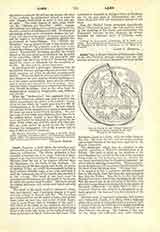

Lamb , PASCHAL, a lamb which the Israelites were commanded to eat with peculiar rites as a part of the Passover celebration. The Divine ordinance is first recorded in Exodus, xii, 3-11, where Yahweh is represented as giving instructions to Moses to preserve the Hebrews from the last of the plagues inflicted upon the Egyptians, viz. the death of the firstborn. On the tenth day of the first month each family (or group of families, if they are small) is commanded to take a lamb without blemish, male, of one year, and keep it until the fourteenth day of the month, and sacrifice it in the evening. The blood of the lamb must be sprinkled on the transom and doorposts of the houses in which the paschal meal is taken. The lamb should be roasted and eaten with unleavened bread and wild lettuce.
The whole of the lamb must be consumed—head, feet, and entrails—and if anything remain of it until morning it must be burned with fire. The Israelites are commanded to eat the meal in haste, with girded loins, shoes on their feet, and staves in their hands, “for it is the Phase (that is, Passage) of the Lord”. The blood of the lamb on the doorposts served as a sign of immunity or protection against the destroying hand of the Lord, who smote in one night all the firstborn in the land of Egypt, both man and beast. This ordinance is repeated in abridged form in Numbers, xix, 11, 12, and again in Deuteronomy, xvi, 2-6, where sheep and oxen are mentioned instead of the lamb.
That the Paschal Lamb prefigured symbolically Christ, “the Lamb of God“, who redeemed the world by the shedding of His blood, and particularly the Eucharistic banquet, or new Passover, has always remained the constant belief of Christian tradition.
JAMES F. DRISCOLL

